Human Resource Management Strategies for Expatriate Success in China
VerifiedAdded on 2021/06/14
|8
|2611
|59
Report
AI Summary
This report delves into the challenges faced by expatriates in China, particularly the language barrier, and proposes effective human resource management (HRM) strategies to mitigate these issues and enhance overall success. The report identifies the language barrier as a significant obstacle, discussing the complexities of the Chinese language and its impact on expatriate performance and customer satisfaction. It then outlines key HRM strategies, including a focus on recruitment and selection processes that assess language skills and family situations, emphasizing training programs to develop linguistic and cultural competencies, establishing clear compensation and reward systems, and fostering regular communication channels to support expatriates. The report highlights the importance of these strategies in reducing expatriate failure, increasing employee satisfaction, and ultimately driving business growth in the competitive Chinese market.
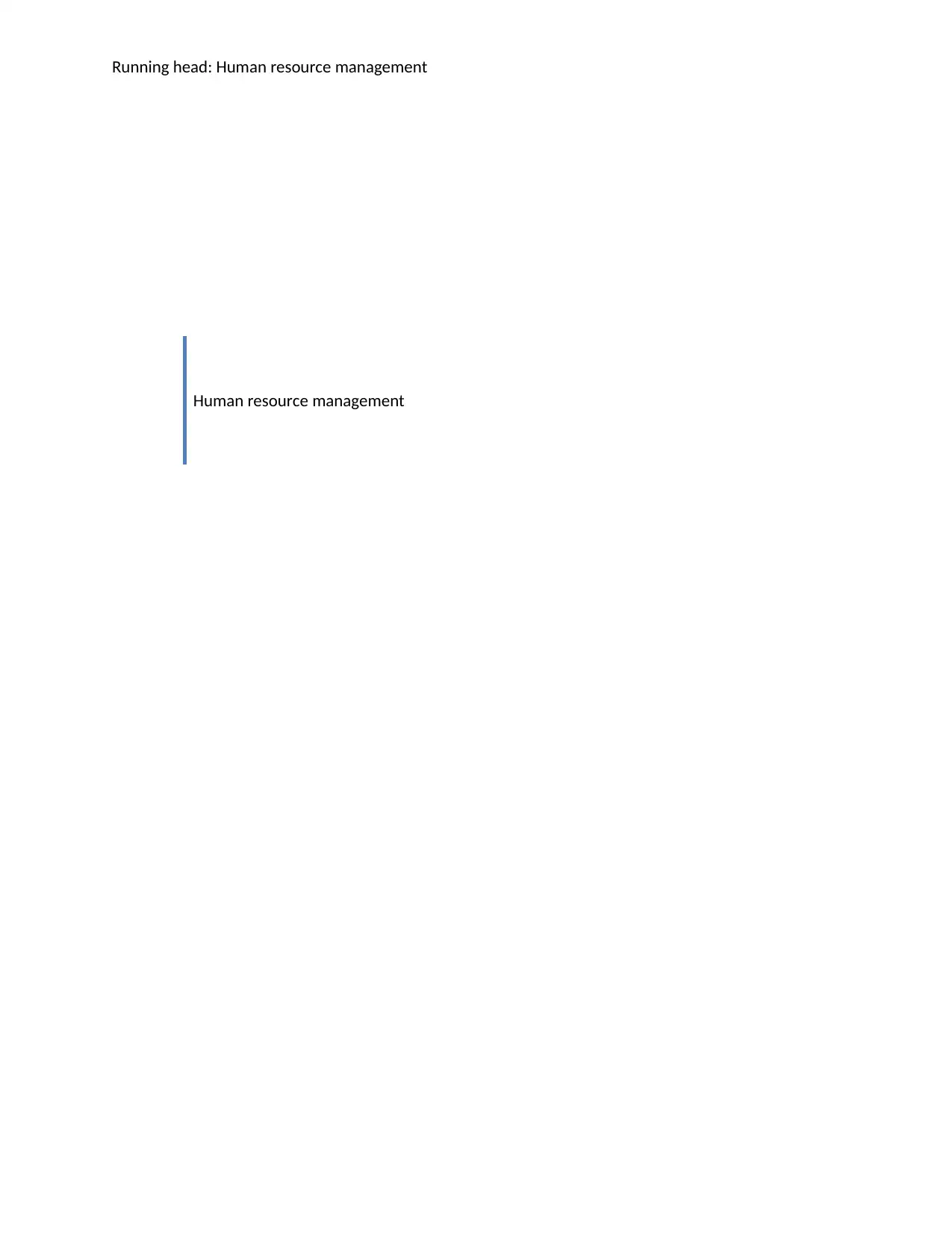
Running head: Human resource management
Human resource management
Human resource management
Paraphrase This Document
Need a fresh take? Get an instant paraphrase of this document with our AI Paraphraser
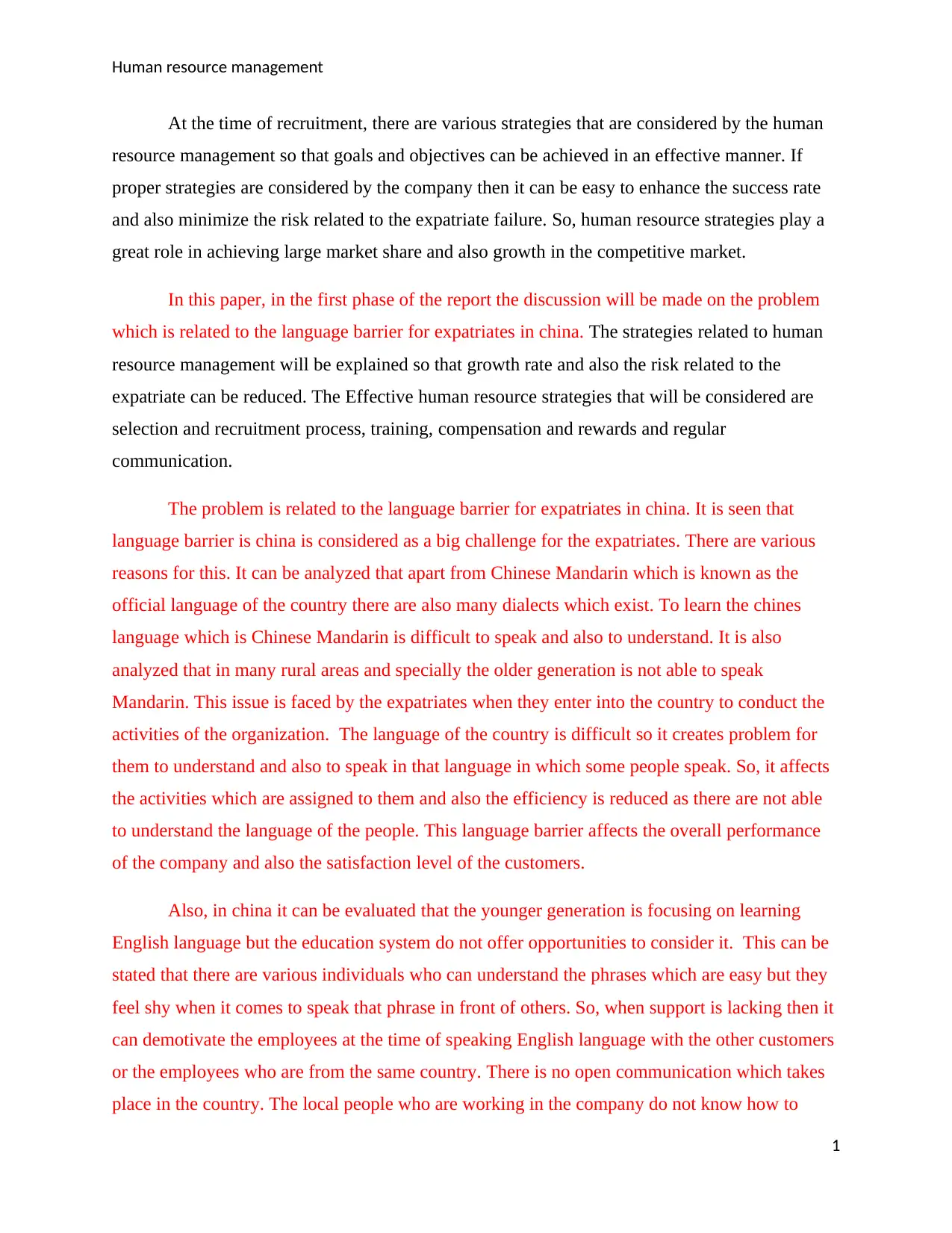
Human resource management
At the time of recruitment, there are various strategies that are considered by the human
resource management so that goals and objectives can be achieved in an effective manner. If
proper strategies are considered by the company then it can be easy to enhance the success rate
and also minimize the risk related to the expatriate failure. So, human resource strategies play a
great role in achieving large market share and also growth in the competitive market.
In this paper, in the first phase of the report the discussion will be made on the problem
which is related to the language barrier for expatriates in china. The strategies related to human
resource management will be explained so that growth rate and also the risk related to the
expatriate can be reduced. The Effective human resource strategies that will be considered are
selection and recruitment process, training, compensation and rewards and regular
communication.
The problem is related to the language barrier for expatriates in china. It is seen that
language barrier is china is considered as a big challenge for the expatriates. There are various
reasons for this. It can be analyzed that apart from Chinese Mandarin which is known as the
official language of the country there are also many dialects which exist. To learn the chines
language which is Chinese Mandarin is difficult to speak and also to understand. It is also
analyzed that in many rural areas and specially the older generation is not able to speak
Mandarin. This issue is faced by the expatriates when they enter into the country to conduct the
activities of the organization. The language of the country is difficult so it creates problem for
them to understand and also to speak in that language in which some people speak. So, it affects
the activities which are assigned to them and also the efficiency is reduced as there are not able
to understand the language of the people. This language barrier affects the overall performance
of the company and also the satisfaction level of the customers.
Also, in china it can be evaluated that the younger generation is focusing on learning
English language but the education system do not offer opportunities to consider it. This can be
stated that there are various individuals who can understand the phrases which are easy but they
feel shy when it comes to speak that phrase in front of others. So, when support is lacking then it
can demotivate the employees at the time of speaking English language with the other customers
or the employees who are from the same country. There is no open communication which takes
place in the country. The local people who are working in the company do not know how to
1
At the time of recruitment, there are various strategies that are considered by the human
resource management so that goals and objectives can be achieved in an effective manner. If
proper strategies are considered by the company then it can be easy to enhance the success rate
and also minimize the risk related to the expatriate failure. So, human resource strategies play a
great role in achieving large market share and also growth in the competitive market.
In this paper, in the first phase of the report the discussion will be made on the problem
which is related to the language barrier for expatriates in china. The strategies related to human
resource management will be explained so that growth rate and also the risk related to the
expatriate can be reduced. The Effective human resource strategies that will be considered are
selection and recruitment process, training, compensation and rewards and regular
communication.
The problem is related to the language barrier for expatriates in china. It is seen that
language barrier is china is considered as a big challenge for the expatriates. There are various
reasons for this. It can be analyzed that apart from Chinese Mandarin which is known as the
official language of the country there are also many dialects which exist. To learn the chines
language which is Chinese Mandarin is difficult to speak and also to understand. It is also
analyzed that in many rural areas and specially the older generation is not able to speak
Mandarin. This issue is faced by the expatriates when they enter into the country to conduct the
activities of the organization. The language of the country is difficult so it creates problem for
them to understand and also to speak in that language in which some people speak. So, it affects
the activities which are assigned to them and also the efficiency is reduced as there are not able
to understand the language of the people. This language barrier affects the overall performance
of the company and also the satisfaction level of the customers.
Also, in china it can be evaluated that the younger generation is focusing on learning
English language but the education system do not offer opportunities to consider it. This can be
stated that there are various individuals who can understand the phrases which are easy but they
feel shy when it comes to speak that phrase in front of others. So, when support is lacking then it
can demotivate the employees at the time of speaking English language with the other customers
or the employees who are from the same country. There is no open communication which takes
place in the country. The local people who are working in the company do not know how to
1
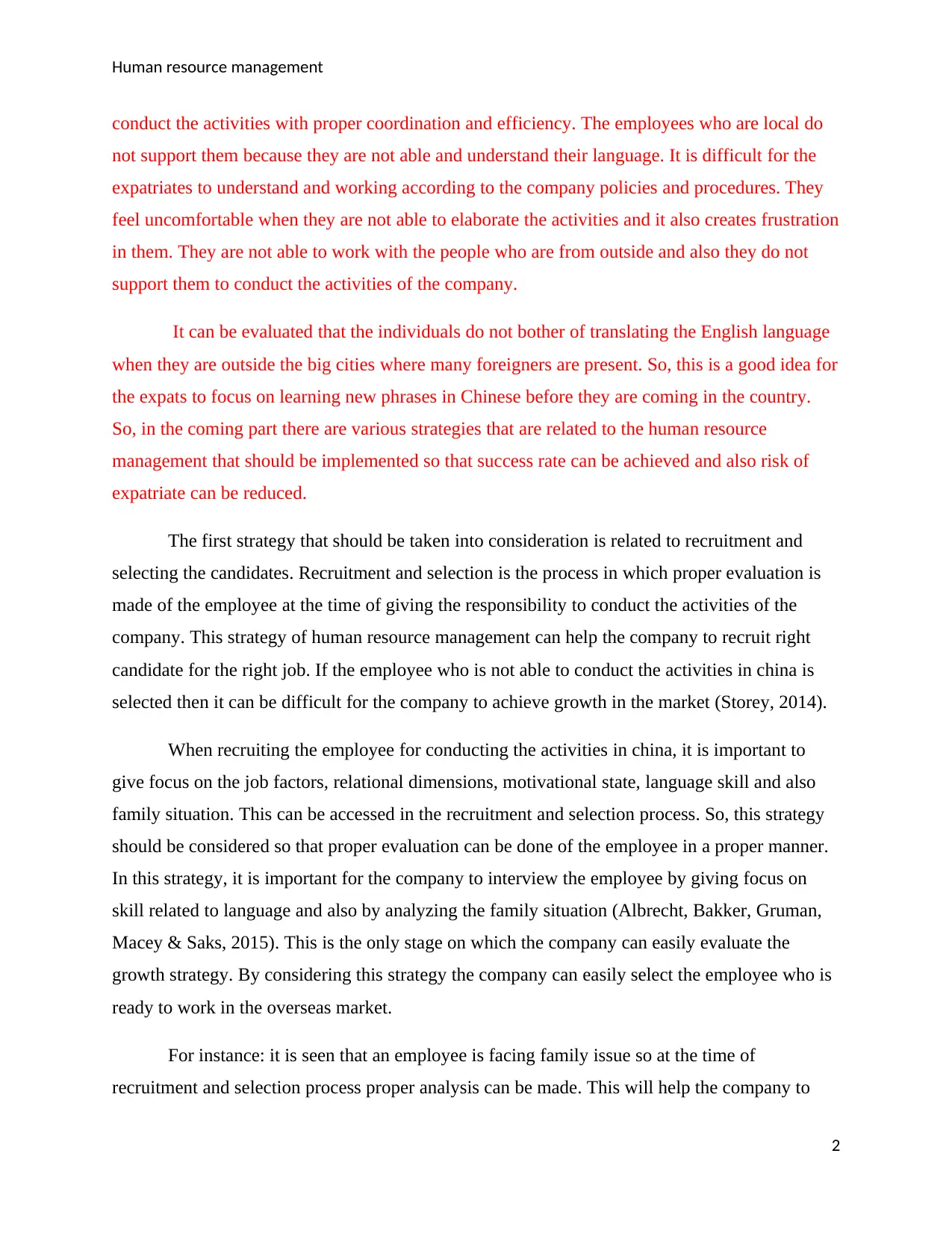
Human resource management
conduct the activities with proper coordination and efficiency. The employees who are local do
not support them because they are not able and understand their language. It is difficult for the
expatriates to understand and working according to the company policies and procedures. They
feel uncomfortable when they are not able to elaborate the activities and it also creates frustration
in them. They are not able to work with the people who are from outside and also they do not
support them to conduct the activities of the company.
It can be evaluated that the individuals do not bother of translating the English language
when they are outside the big cities where many foreigners are present. So, this is a good idea for
the expats to focus on learning new phrases in Chinese before they are coming in the country.
So, in the coming part there are various strategies that are related to the human resource
management that should be implemented so that success rate can be achieved and also risk of
expatriate can be reduced.
The first strategy that should be taken into consideration is related to recruitment and
selecting the candidates. Recruitment and selection is the process in which proper evaluation is
made of the employee at the time of giving the responsibility to conduct the activities of the
company. This strategy of human resource management can help the company to recruit right
candidate for the right job. If the employee who is not able to conduct the activities in china is
selected then it can be difficult for the company to achieve growth in the market (Storey, 2014).
When recruiting the employee for conducting the activities in china, it is important to
give focus on the job factors, relational dimensions, motivational state, language skill and also
family situation. This can be accessed in the recruitment and selection process. So, this strategy
should be considered so that proper evaluation can be done of the employee in a proper manner.
In this strategy, it is important for the company to interview the employee by giving focus on
skill related to language and also by analyzing the family situation (Albrecht, Bakker, Gruman,
Macey & Saks, 2015). This is the only stage on which the company can easily evaluate the
growth strategy. By considering this strategy the company can easily select the employee who is
ready to work in the overseas market.
For instance: it is seen that an employee is facing family issue so at the time of
recruitment and selection process proper analysis can be made. This will help the company to
2
conduct the activities with proper coordination and efficiency. The employees who are local do
not support them because they are not able and understand their language. It is difficult for the
expatriates to understand and working according to the company policies and procedures. They
feel uncomfortable when they are not able to elaborate the activities and it also creates frustration
in them. They are not able to work with the people who are from outside and also they do not
support them to conduct the activities of the company.
It can be evaluated that the individuals do not bother of translating the English language
when they are outside the big cities where many foreigners are present. So, this is a good idea for
the expats to focus on learning new phrases in Chinese before they are coming in the country.
So, in the coming part there are various strategies that are related to the human resource
management that should be implemented so that success rate can be achieved and also risk of
expatriate can be reduced.
The first strategy that should be taken into consideration is related to recruitment and
selecting the candidates. Recruitment and selection is the process in which proper evaluation is
made of the employee at the time of giving the responsibility to conduct the activities of the
company. This strategy of human resource management can help the company to recruit right
candidate for the right job. If the employee who is not able to conduct the activities in china is
selected then it can be difficult for the company to achieve growth in the market (Storey, 2014).
When recruiting the employee for conducting the activities in china, it is important to
give focus on the job factors, relational dimensions, motivational state, language skill and also
family situation. This can be accessed in the recruitment and selection process. So, this strategy
should be considered so that proper evaluation can be done of the employee in a proper manner.
In this strategy, it is important for the company to interview the employee by giving focus on
skill related to language and also by analyzing the family situation (Albrecht, Bakker, Gruman,
Macey & Saks, 2015). This is the only stage on which the company can easily evaluate the
growth strategy. By considering this strategy the company can easily select the employee who is
ready to work in the overseas market.
For instance: it is seen that an employee is facing family issue so at the time of
recruitment and selection process proper analysis can be made. This will help the company to
2
⊘ This is a preview!⊘
Do you want full access?
Subscribe today to unlock all pages.

Trusted by 1+ million students worldwide
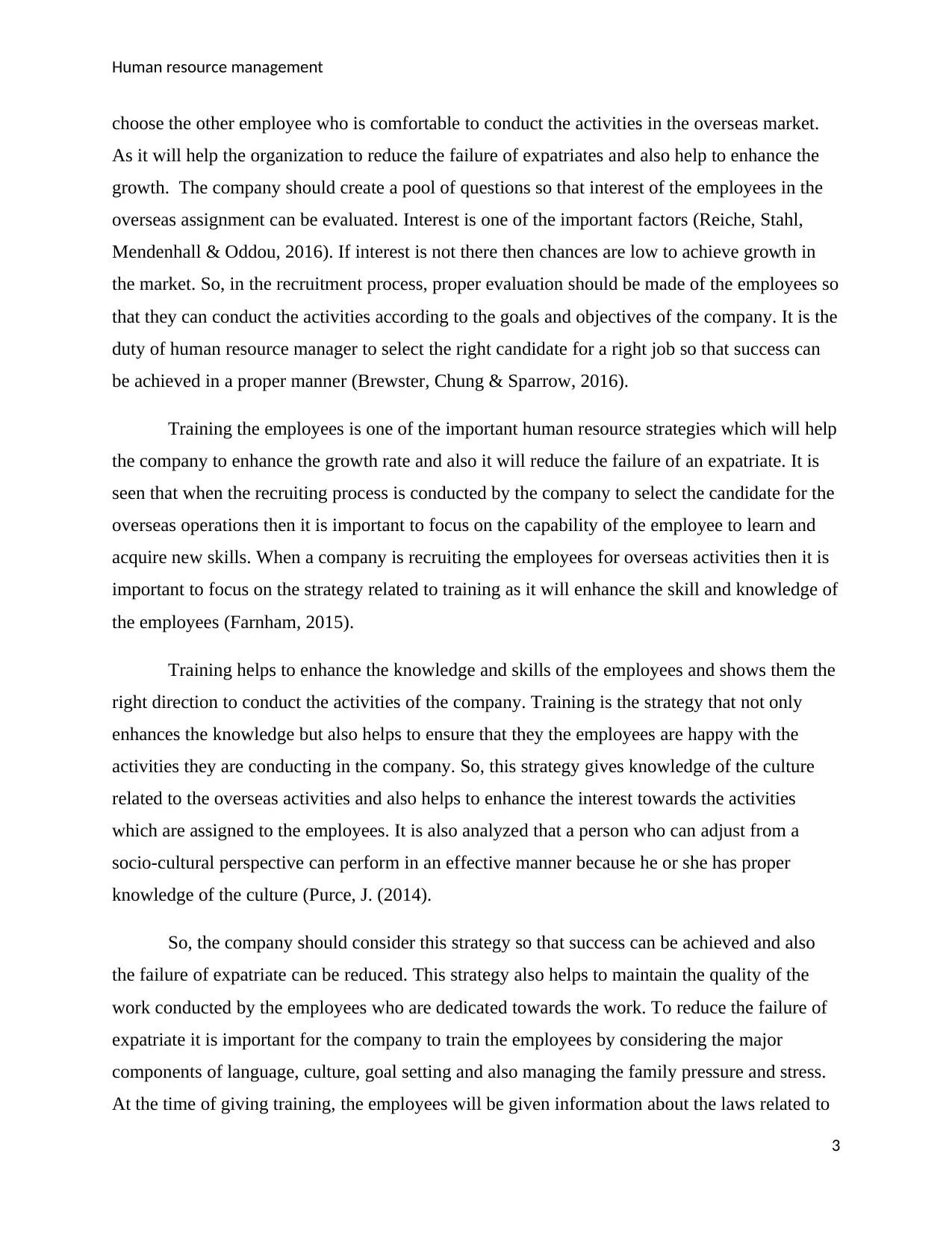
Human resource management
choose the other employee who is comfortable to conduct the activities in the overseas market.
As it will help the organization to reduce the failure of expatriates and also help to enhance the
growth. The company should create a pool of questions so that interest of the employees in the
overseas assignment can be evaluated. Interest is one of the important factors (Reiche, Stahl,
Mendenhall & Oddou, 2016). If interest is not there then chances are low to achieve growth in
the market. So, in the recruitment process, proper evaluation should be made of the employees so
that they can conduct the activities according to the goals and objectives of the company. It is the
duty of human resource manager to select the right candidate for a right job so that success can
be achieved in a proper manner (Brewster, Chung & Sparrow, 2016).
Training the employees is one of the important human resource strategies which will help
the company to enhance the growth rate and also it will reduce the failure of an expatriate. It is
seen that when the recruiting process is conducted by the company to select the candidate for the
overseas operations then it is important to focus on the capability of the employee to learn and
acquire new skills. When a company is recruiting the employees for overseas activities then it is
important to focus on the strategy related to training as it will enhance the skill and knowledge of
the employees (Farnham, 2015).
Training helps to enhance the knowledge and skills of the employees and shows them the
right direction to conduct the activities of the company. Training is the strategy that not only
enhances the knowledge but also helps to ensure that they the employees are happy with the
activities they are conducting in the company. So, this strategy gives knowledge of the culture
related to the overseas activities and also helps to enhance the interest towards the activities
which are assigned to the employees. It is also analyzed that a person who can adjust from a
socio-cultural perspective can perform in an effective manner because he or she has proper
knowledge of the culture (Purce, J. (2014).
So, the company should consider this strategy so that success can be achieved and also
the failure of expatriate can be reduced. This strategy also helps to maintain the quality of the
work conducted by the employees who are dedicated towards the work. To reduce the failure of
expatriate it is important for the company to train the employees by considering the major
components of language, culture, goal setting and also managing the family pressure and stress.
At the time of giving training, the employees will be given information about the laws related to
3
choose the other employee who is comfortable to conduct the activities in the overseas market.
As it will help the organization to reduce the failure of expatriates and also help to enhance the
growth. The company should create a pool of questions so that interest of the employees in the
overseas assignment can be evaluated. Interest is one of the important factors (Reiche, Stahl,
Mendenhall & Oddou, 2016). If interest is not there then chances are low to achieve growth in
the market. So, in the recruitment process, proper evaluation should be made of the employees so
that they can conduct the activities according to the goals and objectives of the company. It is the
duty of human resource manager to select the right candidate for a right job so that success can
be achieved in a proper manner (Brewster, Chung & Sparrow, 2016).
Training the employees is one of the important human resource strategies which will help
the company to enhance the growth rate and also it will reduce the failure of an expatriate. It is
seen that when the recruiting process is conducted by the company to select the candidate for the
overseas operations then it is important to focus on the capability of the employee to learn and
acquire new skills. When a company is recruiting the employees for overseas activities then it is
important to focus on the strategy related to training as it will enhance the skill and knowledge of
the employees (Farnham, 2015).
Training helps to enhance the knowledge and skills of the employees and shows them the
right direction to conduct the activities of the company. Training is the strategy that not only
enhances the knowledge but also helps to ensure that they the employees are happy with the
activities they are conducting in the company. So, this strategy gives knowledge of the culture
related to the overseas activities and also helps to enhance the interest towards the activities
which are assigned to the employees. It is also analyzed that a person who can adjust from a
socio-cultural perspective can perform in an effective manner because he or she has proper
knowledge of the culture (Purce, J. (2014).
So, the company should consider this strategy so that success can be achieved and also
the failure of expatriate can be reduced. This strategy also helps to maintain the quality of the
work conducted by the employees who are dedicated towards the work. To reduce the failure of
expatriate it is important for the company to train the employees by considering the major
components of language, culture, goal setting and also managing the family pressure and stress.
At the time of giving training, the employees will be given information about the laws related to
3
Paraphrase This Document
Need a fresh take? Get an instant paraphrase of this document with our AI Paraphraser
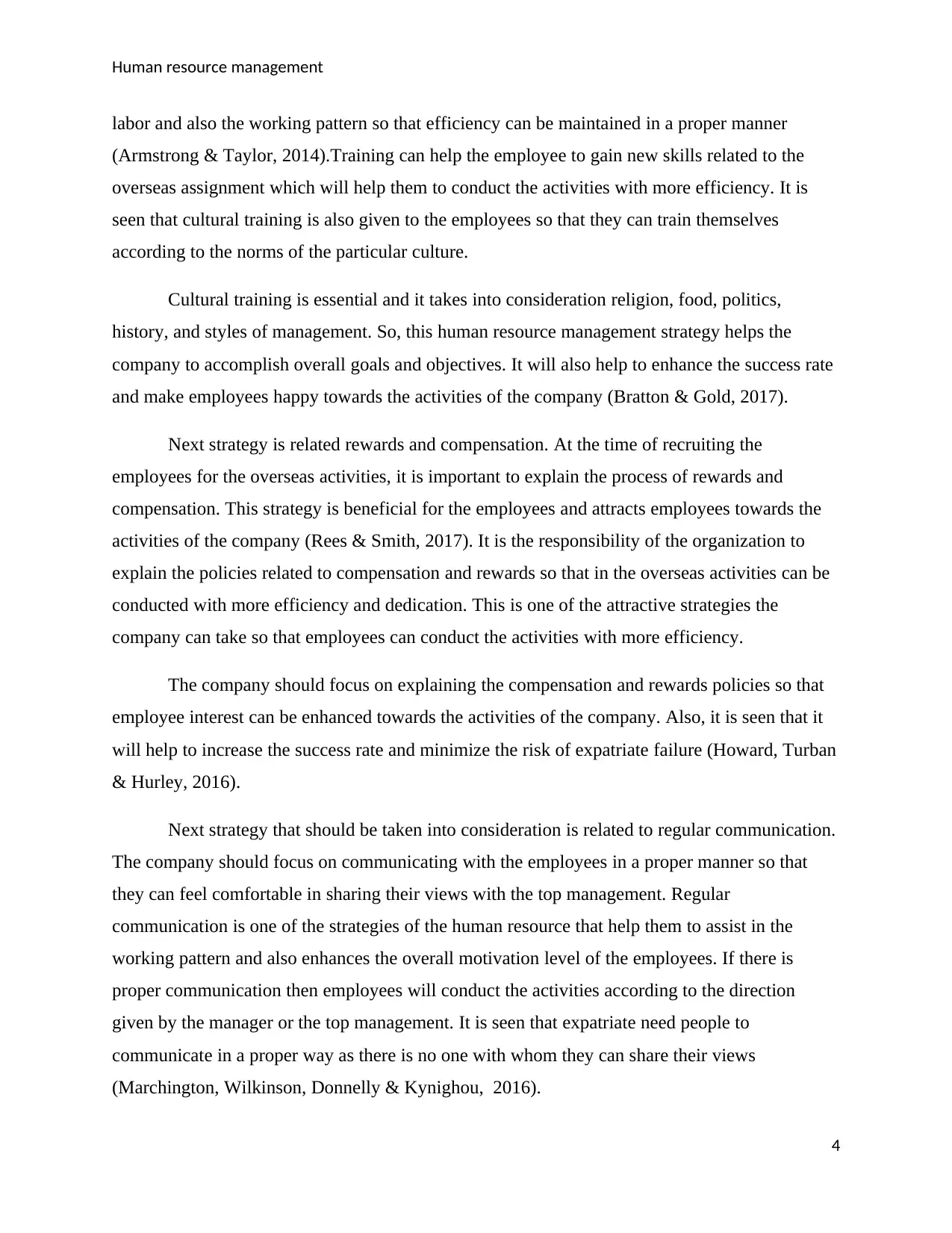
Human resource management
labor and also the working pattern so that efficiency can be maintained in a proper manner
(Armstrong & Taylor, 2014).Training can help the employee to gain new skills related to the
overseas assignment which will help them to conduct the activities with more efficiency. It is
seen that cultural training is also given to the employees so that they can train themselves
according to the norms of the particular culture.
Cultural training is essential and it takes into consideration religion, food, politics,
history, and styles of management. So, this human resource management strategy helps the
company to accomplish overall goals and objectives. It will also help to enhance the success rate
and make employees happy towards the activities of the company (Bratton & Gold, 2017).
Next strategy is related rewards and compensation. At the time of recruiting the
employees for the overseas activities, it is important to explain the process of rewards and
compensation. This strategy is beneficial for the employees and attracts employees towards the
activities of the company (Rees & Smith, 2017). It is the responsibility of the organization to
explain the policies related to compensation and rewards so that in the overseas activities can be
conducted with more efficiency and dedication. This is one of the attractive strategies the
company can take so that employees can conduct the activities with more efficiency.
The company should focus on explaining the compensation and rewards policies so that
employee interest can be enhanced towards the activities of the company. Also, it is seen that it
will help to increase the success rate and minimize the risk of expatriate failure (Howard, Turban
& Hurley, 2016).
Next strategy that should be taken into consideration is related to regular communication.
The company should focus on communicating with the employees in a proper manner so that
they can feel comfortable in sharing their views with the top management. Regular
communication is one of the strategies of the human resource that help them to assist in the
working pattern and also enhances the overall motivation level of the employees. If there is
proper communication then employees will conduct the activities according to the direction
given by the manager or the top management. It is seen that expatriate need people to
communicate in a proper way as there is no one with whom they can share their views
(Marchington, Wilkinson, Donnelly & Kynighou, 2016).
4
labor and also the working pattern so that efficiency can be maintained in a proper manner
(Armstrong & Taylor, 2014).Training can help the employee to gain new skills related to the
overseas assignment which will help them to conduct the activities with more efficiency. It is
seen that cultural training is also given to the employees so that they can train themselves
according to the norms of the particular culture.
Cultural training is essential and it takes into consideration religion, food, politics,
history, and styles of management. So, this human resource management strategy helps the
company to accomplish overall goals and objectives. It will also help to enhance the success rate
and make employees happy towards the activities of the company (Bratton & Gold, 2017).
Next strategy is related rewards and compensation. At the time of recruiting the
employees for the overseas activities, it is important to explain the process of rewards and
compensation. This strategy is beneficial for the employees and attracts employees towards the
activities of the company (Rees & Smith, 2017). It is the responsibility of the organization to
explain the policies related to compensation and rewards so that in the overseas activities can be
conducted with more efficiency and dedication. This is one of the attractive strategies the
company can take so that employees can conduct the activities with more efficiency.
The company should focus on explaining the compensation and rewards policies so that
employee interest can be enhanced towards the activities of the company. Also, it is seen that it
will help to increase the success rate and minimize the risk of expatriate failure (Howard, Turban
& Hurley, 2016).
Next strategy that should be taken into consideration is related to regular communication.
The company should focus on communicating with the employees in a proper manner so that
they can feel comfortable in sharing their views with the top management. Regular
communication is one of the strategies of the human resource that help them to assist in the
working pattern and also enhances the overall motivation level of the employees. If there is
proper communication then employees will conduct the activities according to the direction
given by the manager or the top management. It is seen that expatriate need people to
communicate in a proper way as there is no one with whom they can share their views
(Marchington, Wilkinson, Donnelly & Kynighou, 2016).
4
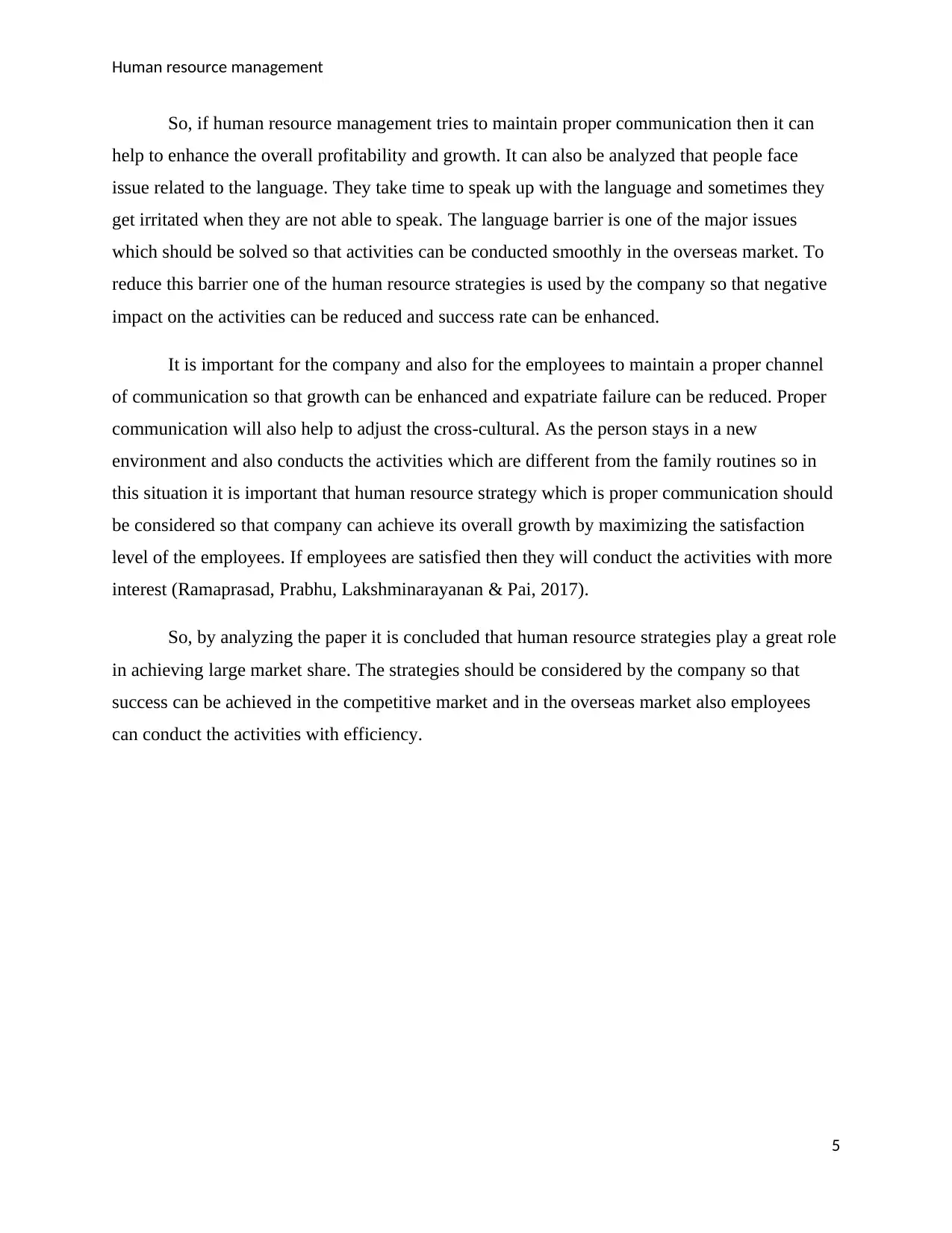
Human resource management
So, if human resource management tries to maintain proper communication then it can
help to enhance the overall profitability and growth. It can also be analyzed that people face
issue related to the language. They take time to speak up with the language and sometimes they
get irritated when they are not able to speak. The language barrier is one of the major issues
which should be solved so that activities can be conducted smoothly in the overseas market. To
reduce this barrier one of the human resource strategies is used by the company so that negative
impact on the activities can be reduced and success rate can be enhanced.
It is important for the company and also for the employees to maintain a proper channel
of communication so that growth can be enhanced and expatriate failure can be reduced. Proper
communication will also help to adjust the cross-cultural. As the person stays in a new
environment and also conducts the activities which are different from the family routines so in
this situation it is important that human resource strategy which is proper communication should
be considered so that company can achieve its overall growth by maximizing the satisfaction
level of the employees. If employees are satisfied then they will conduct the activities with more
interest (Ramaprasad, Prabhu, Lakshminarayanan & Pai, 2017).
So, by analyzing the paper it is concluded that human resource strategies play a great role
in achieving large market share. The strategies should be considered by the company so that
success can be achieved in the competitive market and in the overseas market also employees
can conduct the activities with efficiency.
5
So, if human resource management tries to maintain proper communication then it can
help to enhance the overall profitability and growth. It can also be analyzed that people face
issue related to the language. They take time to speak up with the language and sometimes they
get irritated when they are not able to speak. The language barrier is one of the major issues
which should be solved so that activities can be conducted smoothly in the overseas market. To
reduce this barrier one of the human resource strategies is used by the company so that negative
impact on the activities can be reduced and success rate can be enhanced.
It is important for the company and also for the employees to maintain a proper channel
of communication so that growth can be enhanced and expatriate failure can be reduced. Proper
communication will also help to adjust the cross-cultural. As the person stays in a new
environment and also conducts the activities which are different from the family routines so in
this situation it is important that human resource strategy which is proper communication should
be considered so that company can achieve its overall growth by maximizing the satisfaction
level of the employees. If employees are satisfied then they will conduct the activities with more
interest (Ramaprasad, Prabhu, Lakshminarayanan & Pai, 2017).
So, by analyzing the paper it is concluded that human resource strategies play a great role
in achieving large market share. The strategies should be considered by the company so that
success can be achieved in the competitive market and in the overseas market also employees
can conduct the activities with efficiency.
5
⊘ This is a preview!⊘
Do you want full access?
Subscribe today to unlock all pages.

Trusted by 1+ million students worldwide
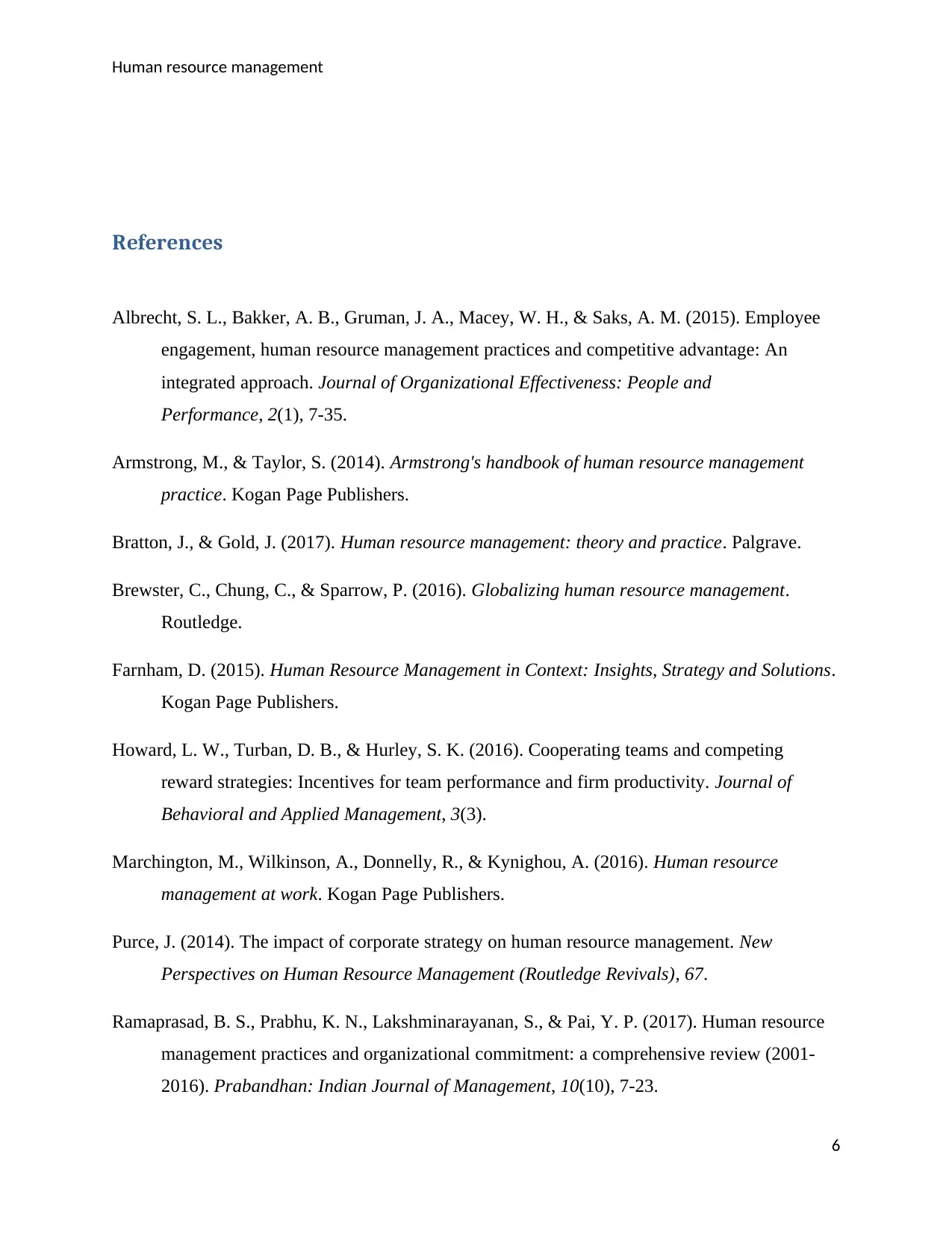
Human resource management
References
Albrecht, S. L., Bakker, A. B., Gruman, J. A., Macey, W. H., & Saks, A. M. (2015). Employee
engagement, human resource management practices and competitive advantage: An
integrated approach. Journal of Organizational Effectiveness: People and
Performance, 2(1), 7-35.
Armstrong, M., & Taylor, S. (2014). Armstrong's handbook of human resource management
practice. Kogan Page Publishers.
Bratton, J., & Gold, J. (2017). Human resource management: theory and practice. Palgrave.
Brewster, C., Chung, C., & Sparrow, P. (2016). Globalizing human resource management.
Routledge.
Farnham, D. (2015). Human Resource Management in Context: Insights, Strategy and Solutions.
Kogan Page Publishers.
Howard, L. W., Turban, D. B., & Hurley, S. K. (2016). Cooperating teams and competing
reward strategies: Incentives for team performance and firm productivity. Journal of
Behavioral and Applied Management, 3(3).
Marchington, M., Wilkinson, A., Donnelly, R., & Kynighou, A. (2016). Human resource
management at work. Kogan Page Publishers.
Purce, J. (2014). The impact of corporate strategy on human resource management. New
Perspectives on Human Resource Management (Routledge Revivals), 67.
Ramaprasad, B. S., Prabhu, K. N., Lakshminarayanan, S., & Pai, Y. P. (2017). Human resource
management practices and organizational commitment: a comprehensive review (2001-
2016). Prabandhan: Indian Journal of Management, 10(10), 7-23.
6
References
Albrecht, S. L., Bakker, A. B., Gruman, J. A., Macey, W. H., & Saks, A. M. (2015). Employee
engagement, human resource management practices and competitive advantage: An
integrated approach. Journal of Organizational Effectiveness: People and
Performance, 2(1), 7-35.
Armstrong, M., & Taylor, S. (2014). Armstrong's handbook of human resource management
practice. Kogan Page Publishers.
Bratton, J., & Gold, J. (2017). Human resource management: theory and practice. Palgrave.
Brewster, C., Chung, C., & Sparrow, P. (2016). Globalizing human resource management.
Routledge.
Farnham, D. (2015). Human Resource Management in Context: Insights, Strategy and Solutions.
Kogan Page Publishers.
Howard, L. W., Turban, D. B., & Hurley, S. K. (2016). Cooperating teams and competing
reward strategies: Incentives for team performance and firm productivity. Journal of
Behavioral and Applied Management, 3(3).
Marchington, M., Wilkinson, A., Donnelly, R., & Kynighou, A. (2016). Human resource
management at work. Kogan Page Publishers.
Purce, J. (2014). The impact of corporate strategy on human resource management. New
Perspectives on Human Resource Management (Routledge Revivals), 67.
Ramaprasad, B. S., Prabhu, K. N., Lakshminarayanan, S., & Pai, Y. P. (2017). Human resource
management practices and organizational commitment: a comprehensive review (2001-
2016). Prabandhan: Indian Journal of Management, 10(10), 7-23.
6
Paraphrase This Document
Need a fresh take? Get an instant paraphrase of this document with our AI Paraphraser
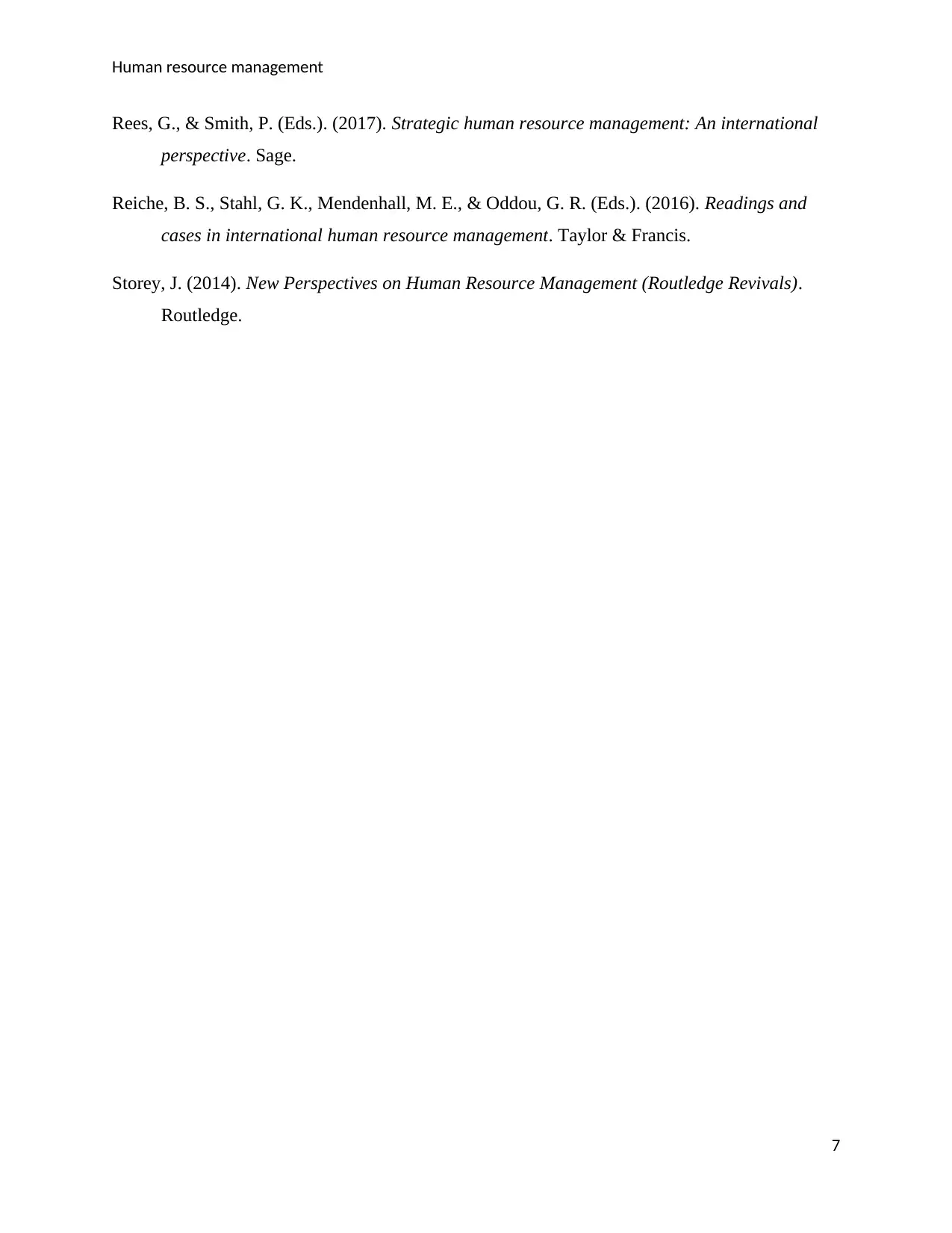
Human resource management
Rees, G., & Smith, P. (Eds.). (2017). Strategic human resource management: An international
perspective. Sage.
Reiche, B. S., Stahl, G. K., Mendenhall, M. E., & Oddou, G. R. (Eds.). (2016). Readings and
cases in international human resource management. Taylor & Francis.
Storey, J. (2014). New Perspectives on Human Resource Management (Routledge Revivals).
Routledge.
7
Rees, G., & Smith, P. (Eds.). (2017). Strategic human resource management: An international
perspective. Sage.
Reiche, B. S., Stahl, G. K., Mendenhall, M. E., & Oddou, G. R. (Eds.). (2016). Readings and
cases in international human resource management. Taylor & Francis.
Storey, J. (2014). New Perspectives on Human Resource Management (Routledge Revivals).
Routledge.
7
1 out of 8
Related Documents
Your All-in-One AI-Powered Toolkit for Academic Success.
+13062052269
info@desklib.com
Available 24*7 on WhatsApp / Email
![[object Object]](/_next/static/media/star-bottom.7253800d.svg)
Unlock your academic potential
Copyright © 2020–2025 A2Z Services. All Rights Reserved. Developed and managed by ZUCOL.





